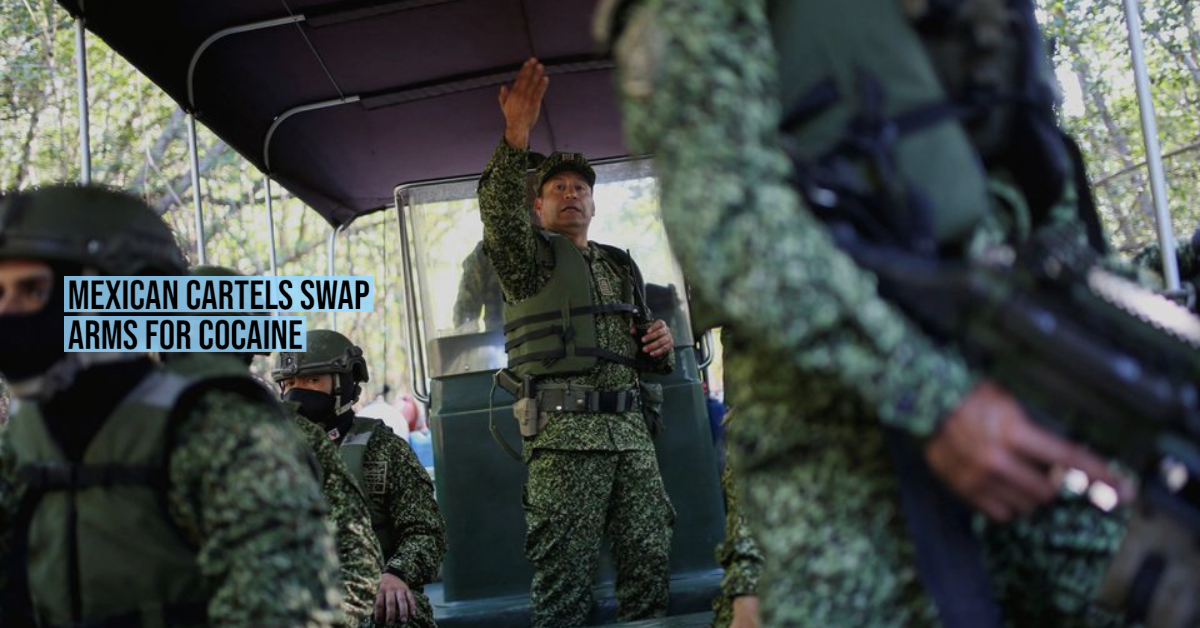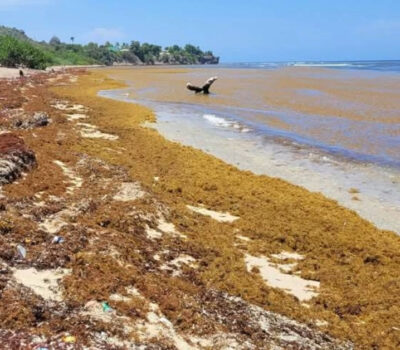Mexican drug cartels appear to be shipping high-powered weapons to Colombia to purchase shipments of cocaine, a trade Colombian authorities say is fueling the deadly struggle between rival traffickers for control of the nation’s drug routes.
A bevy of machine guns, assault rifles and semi-automatic handguns are flowing into the South American country, a dozen Colombian law enforcement officials told Reuters.
Among the weapons popping up in traffickers’ arsenals is the Belgium-made FN Five-seveN pistol, sources said. Nicknamed the “cop killer,” the 5.7-caliber weapon can penetrate bullet-proof vests.
Most of the 1,478 long arms confiscated from Colombian armed groups in 2020 and 2021 were foreign-made and imported clandestinely, the police say, along the same smuggling routes used to get drugs out.
Mexican drug gangs have easy access to guns purchased in the United States and long-term business relationships with Colombian armed groups, from whom they have purchased cocaine for decades, Colombian authorities said.
Now cartel emissaries are increasingly paying for shipments of cocaine with guns, authorities say, in part to avoid the need to move large quantities of cash across borders.
The potent firepower of the cartel-supplied arsenal has potential implications for Colombia’s security. Heavy arms in the hands of criminals put law enforcement at risk and could further complicate the troubled implementation of a 2016 peace deal between Bogota and the Revolutionary Armed Forces of Colombia (FARC) rebels.
Last year 148 members of the armed forces and the national police were killed in Colombia, the highest figure in six years and a 57% increase from 2020, according to figures from the Ministry of Defense.
“What illegal armed groups in Colombia are doing is using the Mexicans to equal and exceed the armed forces of the state in terms of weaponry,” an official at the police’s Anti-Terrorism and Arms Tracing Information Center (CIARA) said.
“In the future, that could have serious implications, like an increase in hostilities,” according to the official, who said armed groups may use the weapons not only against law enforcement but in battles with each other.
The agency authorized the person to speak to Reuters on the condition they not be identified.
The Colombian police say they have a permanent dialogue with their U.S. and Mexican counterparts on keeping weapons out of drug traffickers’ hands.
The U.S. Drug Enforcement Administration (DEA) declined to comment, while the Mexican government did not respond to Reuters questions.
MEXICAN CONNECTION
Colombian authorities say the battle for control of their country’s drug trade is waged between former FARC members who reject the peace accord; guerrillas from the still-active National Liberation Army (ELN); and members of a plethora of criminal syndicates, including the Clan del Golfo, Colombia’s largest cartel.
Though FARC dissidents and the ELN espouse some of the same Marxist ideals, and they occasionally allied against the government during the height of the civil war, they now regularly fight each other and rival crime gangs to dominate lucrative drug routes, security officials said.
Law enforcement encounters with these groups are turning up powerful weapons.
In mid-December last year, Colombia’s army conducted an operation against FARC dissidents in southwestern Narino province, a major coca-producing region. The military said it captured 16 people and seized a cache of weapons, including 24 U.S.-made M16 assault rifles and AR-15 semiautomatic rifles.
A similar haul was found in a different FARC dissident camp in the southern jungle province of Caqueta in 2019, according to the army: a M60 machine gun, an AR-15 rifle with an added scope for use by a sniper, and a dozen assault rifles, including M4s and M16s.
Authorities said they believe such guns are supplied by Mexico’s Sinaloa, Zeta and Jalisco New Generation cartels, all of which have emissaries on Colombian soil.
Their representatives are present in 11 of Colombia’s 32 provinces, according to a 2021 police intelligence report seen by Reuters.
The Sinaloa cartel, once headed by jailed kingpin Joaquin “El Chapo” Guzman, has the most extensive geographic reach and deepest relationships with Colombian armed groups, the report said.
Some 55 Mexicans have been accused or convicted of drug trafficking offenses in Colombia in the last three years, according to the national prisons agency.
Colombia’s national police said last week they had captured Brian Donaciano Olguin, a Mexican national whom they allege served as the Sinaloa cartel’s most important go-between with FARC dissidents, calling his arrest the most important yet of a cartel emissary. Reuters was unable to contact Olguin or determine if he has legal counsel.
Mexico’s warring drug gangs have been bulking up on military-grade armaments at home, alarming officials in their own country. read more
Last year, Mexican President Andres Manuel Lopez Obrador’s government sued gunmakers, accusing them of facilitating weapons trafficking, which the gunmakers deny. read more
U.S. gunmakers support stronger enforcement of existing laws, including imprisoning people who steal and smuggle guns, Mark Oliva, director for public affairs at the National Shooting Sports Foundation, a firearms industry trade group, said in an email.
Guns are a handy form of currency for gangsters.
Paying coke suppliers with weapons, rather than bulky cash, helps Mexican cartels launder profits and move money around more easily, said General Fernando Murillo, head of DIJIN, the investigative division of Colombia’s national police.
“Every day (conducting) drug trafficking through cash payments gets more difficult. So now they are using different methods: a Mexican cartel might pay with sophisticated arms,” Murillo said.
TRADING UP
Until the 1990s, Colombian guerrillas and right-wing paramilitaries largely used Russian-made AK-47s left over from wars in Central America, officials from the police and armed forces told Reuters.
As drug trafficking expanded and grew more lucrative, armed groups upgraded to newer AK-47s, U.S.-made M16s and AR-15s and Israeli-made Tavor assault rifles, police officials said. While some guns go for as little at $500 in Colombia, machine guns can fetch up to $5,000, they said.
The leaders of the Segunda Marquetalia, a group of FARC dissidents, have appeared repeatedly in YouTube videos armed with Tavor assault rifles likely supplied by Mexican cartels, according to the police’s CIARA center.
The U.S. DEA estimates Colombian criminal groups earn some $10 billion from drug transactions per year.
The flow of weapons southward comes as Colombian provinces like Norte de Santander, on the border with Venezuela, and Narino and Cauca, on the Pacific coast, have seen increases in coca production and associated violence by armed groups, despite U.S.-backed efforts by President Ivan Duque to slash narcotics production.
The Clan del Golfo alone moves some 20 tonnes of cocaine per month for clients including the Sinaloa and Jalisco cartels, according to Colombian police, who say the Clan’s gangster allies in Medellin have used the FN Five-seveN pistol in internal disputes.
It is possible some cartel-supplied guns enter Colombia through Venezuela, officials from the Colombian police and army say.
Dissident leaders like Ivan Marquez, who heads Segunda Marquetalia, meet in Venezuela with Sinaloa and Jalisco emissaries, General Jorge Luis Vargas, the head of the national police, told Reuters.
Bogota has long accused Venezuela’s government of providing refuge for Colombian armed groups, including dissidents, allegations denied by Venezuelan President Nicolas Maduro.
The Venezuelan government did not respond to a request for comment.
Reporting by Luis Jaime Acosta in Bogota and Tumaco, Colombia; additional reporting by Diego Ore and Drazen Jorgic in Mexico City, Vivian Sequera in Caracas and Matt Spetalnick in Washington; editing by Marla Dickerson, Julia Symmes Cobb and Daniel Flynn
Mexican drug cartels appear to be shipping high-powered weapons to Colombia to purchase shipments of cocaine, a trade Colombian authorities say is fueling . . .












